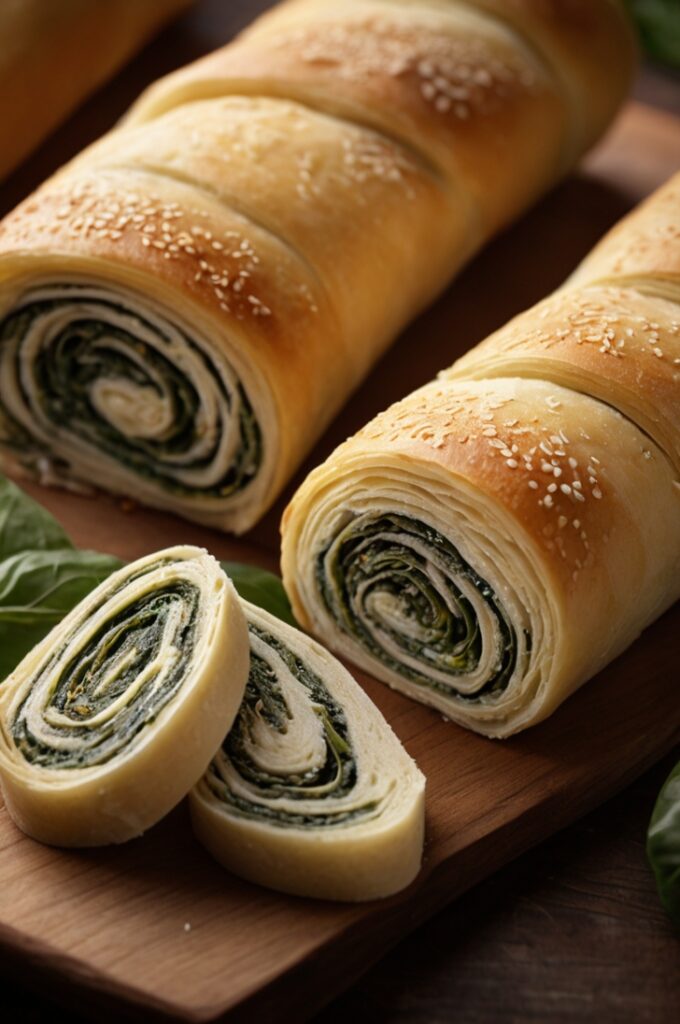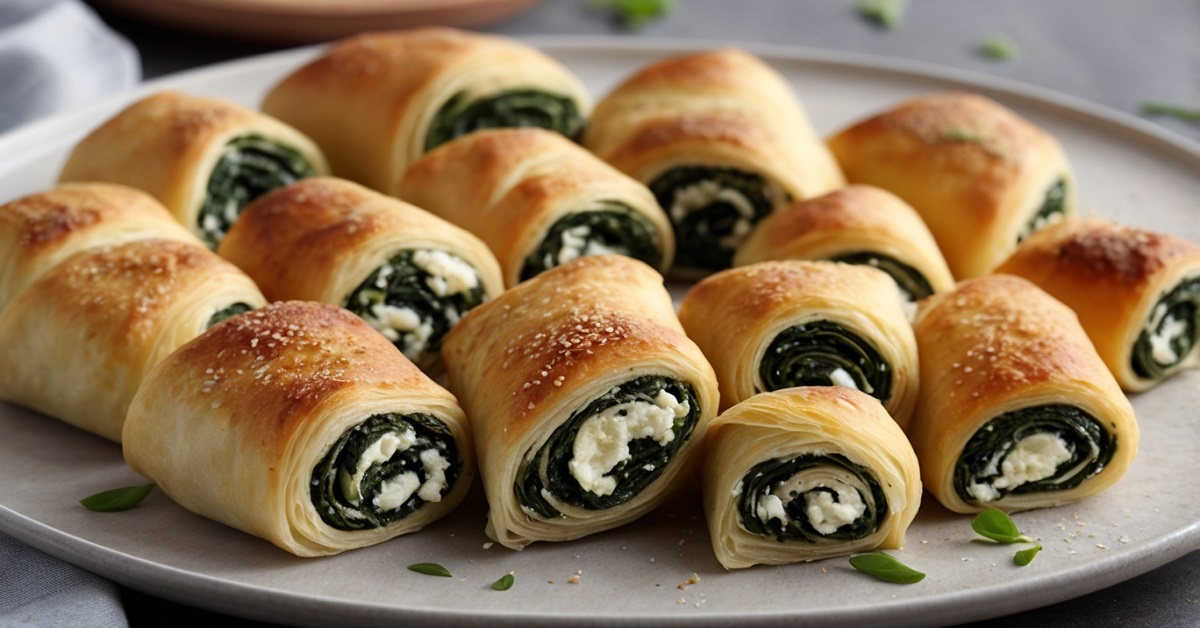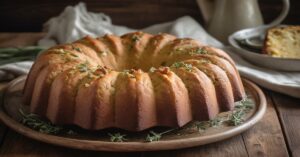First time I had a spinach and ricotta rolls recipe like really had it, not the sad, fridge-case version, but a fresh one, flaky and warm I was standing outside a bakery in Melbourne. Drizzle overhead. Bit hungover.
One bite in, I stopped walking. Couldn’t believe something so green could taste so rich. Nothing fancy, no garnish, just buttery pastry hugging the silkiest, cheesiest filling. It hit different. Still does.
This recipe is about that roll. That flaky, buttery, pepper-flecked pastry, and the warm, almost custardy filling. It’s not flashy, but it delivers like a freight train. And when it’s done right good God, it’s got that elusive thing. That pastry-to-filling magic ratio.
This one’s for chefs who know that layering flavour starts way before the oven door shuts.
What Are Spinach and Ricotta Rolls?

They’re like a vegetarian answer to sausage rolls. But calling them “veg sausage rolls” is selling ‘em short. The filling’s a pillowy, cheesy, herby mix of ricotta, wilted spinach, egg, and seasoning. Wrapped in puff pastry. Baked ‘til golden and audibly crisp.
What sets them apart? They’re subtle but rich. Light but not boring. And endlessly riffable.
Used to be the domain of bakeries and potlucks, now they’ve landed on upscale brunch menus. But make ‘em at home, with some intention, and they’ll outclass half the mains on a restaurant list.
Ingredients & Substitutions
Let’s break it down. And not just what goes in but why it matters.
For the Filling
- 400g baby spinach (or frozen spinach, well-drained)
- 250g ricotta (full-fat, always)
- 1 large egg (binds it all together)
- 50g grated parmesan (sharpens the mix)
- 1 garlic clove, minced
- ¼ tsp freshly grated nutmeg
- Salt & black pepper to taste
- Zest of half a lemon (sounds optional, isn’t)
Substitutions? Sure, but choose wisely.
Frozen spinach works, but squeeze it drier than you think. Watery filling = sad pastry. Goat cheese can sub for ricotta if you want a bit more tang, but cut it with cream cheese or it’ll be too sharp. Vegans can go for firm tofu blitzed with lemon and nutritional yeast, but they’ll need breadcrumbs to help bind.
Parmesan skip if you must, but it adds an edge. Pecorino’s a great sub, but saltier, so taste and adjust.
Fresh nutmeg matters. The jarred stuff’s like perfume left out in the rain.
For the Pastry
- 2 sheets of puff pastry, thawed if frozen
- 1 egg (for egg wash)
- Sesame seeds or poppy seeds for topping (optional but nice)
Store-bought puff is fine, but all-butter puff pastry? That’s the baller move. You’ll taste the difference.
If you’re making from scratch respect. But don’t laminate unless you’ve got hours and good air con.
Step-by-Step Instructions
Time to get our hands messy.
1. Wilt the Spinach
Toss spinach in a hot pan with a glug of olive oil and a pinch of salt. Just a minute or two, until it collapses.
Dump it into a colander. Press, squeeze, wring get that moisture out. Like, really squeeze it. I’ve seen this ruin otherwise beautiful rolls. Wet filling = leaky pastry.
2. Make the Filling
Chop the spinach roughly. Toss into a bowl with ricotta, egg, parmesan, garlic, nutmeg, lemon zest, salt, pepper.
Mix it with a fork, not a spoon. You want a soft crumble, not baby food.
Taste it. Adjust. This is your only shot before the oven locks it in.
3. Prep the Pastry
Unroll your puff on a lightly floured board. Cut each sheet in half so you have 4 rectangles.
Lay them landscape, short side facing you. Spoon the filling in a log shape down the center of each.
Leave some breathing room on both sides. You’re not rolling a burrito here.
4. Roll & Seal
Brush one long edge with water. Fold the dry side over the filling, then roll toward the wet edge to seal.
Seam-side down always. Slice each log into two or three mini-rolls.
If the kitchen’s hot, chill them for 10 before baking. Keeps the puff snappy.
5. Egg Wash & Bake
Brush the tops with beaten egg. Sprinkle sesame or poppy seeds if you’re fancy.
Into a 200°C (390°F) oven for 25–30 minutes. You want deep gold, not just blonde.
If they’re leaking, don’t sweat it. Leaks = flavour on the tray. Scrape it up and eat it.
Technique & Science
So why this method? What’s happening in the guts of this thing?
Spinach, when raw, is all water and fluff. Cooking it shrinks it and breaks cell walls. Squeezing it gets rid of that water so your filling stays dense, not soupy.
Ricotta gives structure, but it’s fragile. That’s why we bind with egg. Parmesan adds umami and helps soak moisture, tightening the mix just a bit.
Nutmeg? Seems old-school. But it’s not about the taste. It’s about aroma. It lifts the whole thing. Warms the back of the mouth in a way nothing else does.
Puff pastry works in layers. Cold butter hits hot air poof. You get lift, steam, crunch. That’s why cold rolls and hot ovens matter.
Egg wash? That’s your golden ticket. It browns, it glazes, it makes people want to grab one off the tray before asking.
Serving & Pairing Suggestions

These rolls are versatile little monsters. Brunch? Absolutely. Light lunch? With salad, perfect. Cocktail snack? Make them bite-sized.
Try a dollop of tomato chutney. Or a yoghurt dip laced with lemon and za’atar. Anything with acidity helps slice through the richness.
Drink-wise? A cold pale ale balances the fat beautifully. Prosecco if you’re being bougie. Even a young pinot grigio works.
For sides: Think bitter leaves. Rocket with balsamic. Shaved fennel with citrus. You want crunch and bite.
Plating? Stack ‘em. Scatter some herbs. Serve on a cutting board like you just whipped them up casually, even if you stressed for two hours.
Why These Rolls Work
They hit that rare note: comfort and finesse.
Crispy outside, creamy inside. But not mushy. Subtle seasoning, but with high payoff if you layer smart. And they hold. They’re good hot, warm, or cold.
They also teach restraint. You learn not to overseason. Not to overfill. Not to overbake. They reward patience.
And you can riff. Add sun-dried tomatoes. Chili flakes. Swap ricotta for whipped feta. Add dill. Make ‘em yours.
FAQs About Spinach and Ricotta Rolls Recipe
Can I freeze spinach and ricotta rolls before baking?
Absolutely. Line them on a tray, freeze until solid, then transfer to a bag. Bake from frozen, no need to thaw just extend baking time by ~10 minutes.
Why is my filling leaking out of the pastry?
Usually from overfilling, not sealing properly, or using a filling that’s too wet. Squeeze the spinach hard and don’t skip the egg binder.
What type of ricotta works best?
Full-fat, firm ricotta from a deli or specialty store is ideal. The supermarket tub stuff can be too wet drain it overnight in a cheesecloth if needed.
Can I make these gluten-free?
Yes, but you’ll need a good-quality gluten-free puff pastry. Some brands are brittle, so handle gently. Also check your ricotta for any additives that may contain gluten.
How do I reheat them without losing the crisp?
Oven or toaster oven, 180°C (350°F) for about 10 minutes. Avoid the microwave unless you enjoy limp, chewy pastry (no judgment, just facts).
Spinach and ricotta rolls might look simple, but they’re a chef’s canvas. When you nail them, people notice. And they’ll ask for the recipe. Every time.
You just gonna hand it over?
Or keep the secret a bit longer?
Want a variation with spiced lamb or feta and mint?
Final Tips & Common Pitfalls
- Don’t overfill. It’s tempting. Resist. Overflow kills your seams and ruins the puff.
- Soggy bottoms? Use a baking steel or preheated tray.
- Batch ahead. Freeze unbaked rolls, then bake straight from frozen (add 10 mins).
- Egg-free? Brush with milk or plant-based milk + maple for colour.
- Need crunch? Add crushed pine nuts or toasted walnuts to the filling.




